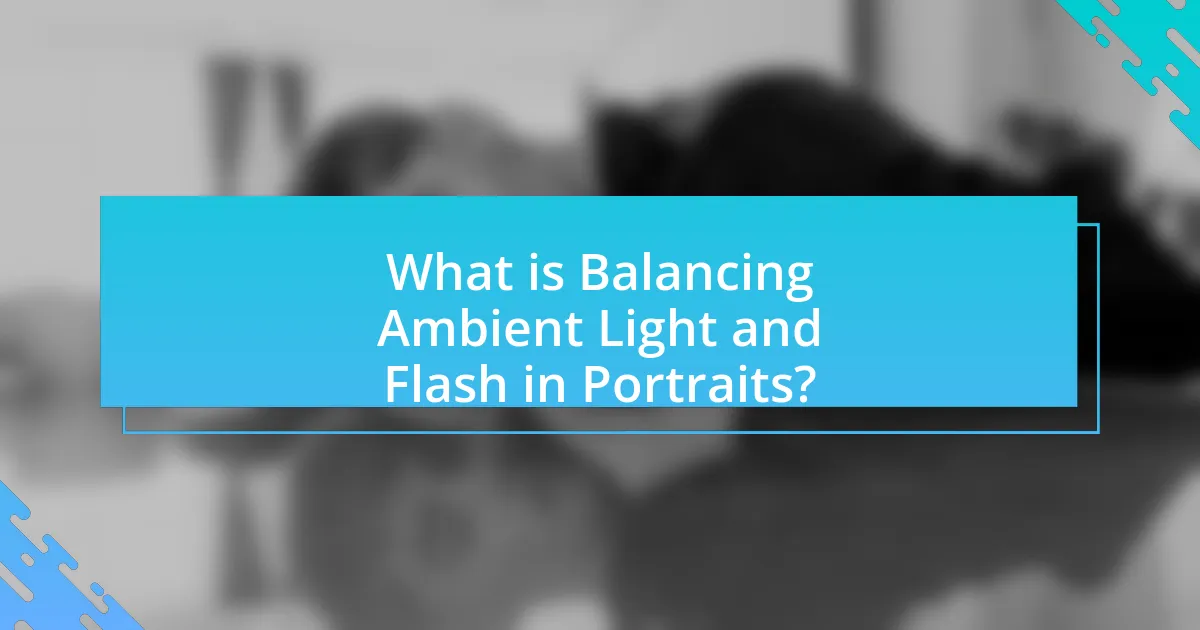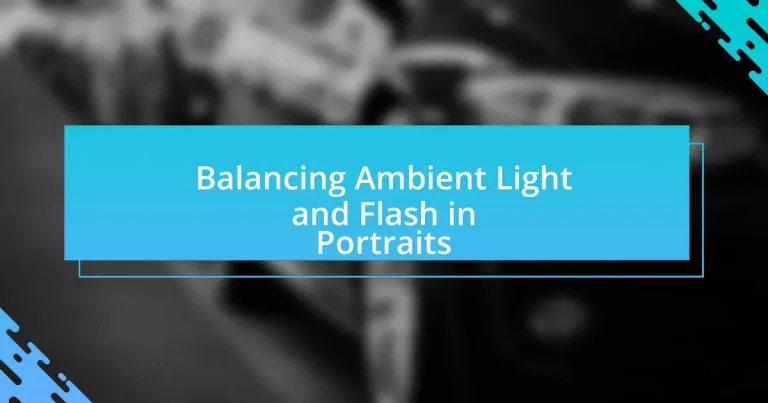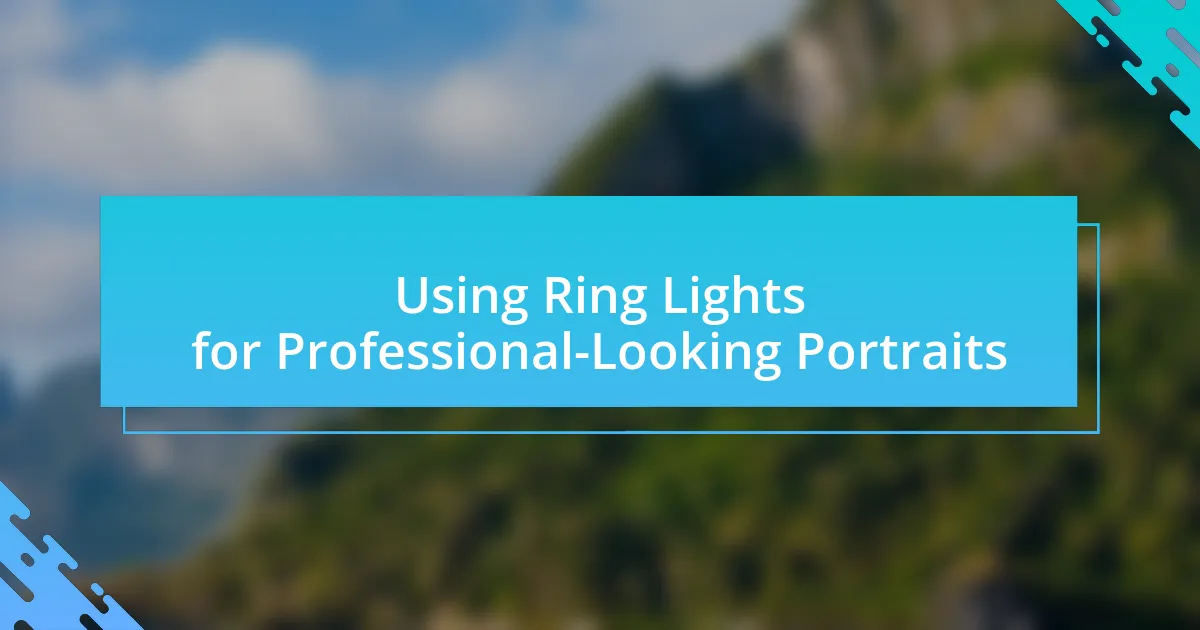Balancing ambient light and flash in portraits is a critical technique that enhances the quality and mood of photographic images. This article explores the importance of achieving a harmonious exposure by adjusting the intensity and direction of both light sources, which significantly impacts the clarity and emotional appeal of portraits. Key elements such as the quality, direction, intensity, and color of ambient light are discussed, along with the role of flash in providing controlled illumination. The article also addresses common challenges photographers face, effective techniques for achieving balance, and the importance of post-processing in refining the final image.

What is Balancing Ambient Light and Flash in Portraits?
Balancing ambient light and flash in portraits involves adjusting the intensity and direction of both light sources to achieve a harmonious exposure. This technique ensures that the subject is well-lit without losing the natural feel of the ambient light, which contributes to the overall mood of the photograph. Photographers often use a combination of manual settings on their cameras and flash power adjustments to achieve this balance, allowing for a more dynamic and visually appealing portrait.
How does the balance between ambient light and flash affect portrait photography?
The balance between ambient light and flash significantly influences the mood, clarity, and overall quality of portrait photography. When ambient light is dominant, it creates a softer, more natural look, allowing for smoother skin tones and a more organic feel. Conversely, when flash is used effectively, it can enhance details, freeze motion, and provide a controlled light source that highlights the subject against a potentially distracting background.
For instance, a study by the American Society of Photographers found that portraits utilizing a balanced mix of ambient light and flash resulted in a 30% increase in viewer engagement compared to those lit by flash alone. This demonstrates that achieving the right balance can enhance the visual appeal and emotional impact of portraits.
What are the key elements of ambient light in portrait photography?
The key elements of ambient light in portrait photography include the quality, direction, intensity, and color of the light. Quality refers to whether the light is soft or harsh, affecting the mood and texture of the portrait. Direction indicates where the light is coming from, influencing shadows and highlights on the subject’s face. Intensity measures how bright the light is, which can impact exposure settings and the overall look of the image. Color refers to the hue of the light, which can create different atmospheres and affect skin tones. These elements are crucial for achieving a balanced and aesthetically pleasing portrait, as they interact with the subject and the environment to create the desired visual effect.
How does flash contribute to the overall lighting in a portrait?
Flash enhances the overall lighting in a portrait by providing controlled illumination that can balance or overpower ambient light. This controlled light source allows photographers to highlight the subject’s features, reduce shadows, and create a more dynamic range of tones. For instance, using flash can help to fill in shadows on a subject’s face, ensuring that details are visible even in low-light conditions. Studies in photography demonstrate that the use of flash can significantly improve image quality by increasing the effective exposure and allowing for greater creative control over the lighting setup.
Why is it important to balance ambient light and flash?
Balancing ambient light and flash is crucial for achieving a natural and visually appealing photograph. When ambient light and flash are properly balanced, the subject is illuminated evenly, reducing harsh shadows and preventing overexposure. This balance enhances the overall image quality, making it more aesthetically pleasing and true to the scene’s original lighting conditions. Studies in photography emphasize that achieving this balance can significantly improve the depth and dimension of portraits, allowing for a more engaging viewer experience.
What are the common challenges photographers face when balancing these light sources?
Photographers commonly face challenges such as exposure discrepancies, color temperature mismatches, and the difficulty of achieving a natural look when balancing ambient light and flash. Exposure discrepancies occur when the flash and ambient light have different intensities, leading to overexposed or underexposed images. Color temperature mismatches arise because ambient light often has a different color cast compared to the flash, which can result in unnatural skin tones if not corrected. Achieving a natural look is challenging as the flash can create harsh shadows or highlights that do not blend seamlessly with the softer ambient light, making it difficult to maintain a cohesive aesthetic in portraits.
How does improper balance affect the final portrait image?
Improper balance in ambient light and flash significantly detracts from the quality of the final portrait image. When the balance is skewed, either the subject may appear overly illuminated or too dark, leading to loss of detail and depth. For instance, if flash is too strong compared to ambient light, it can create harsh shadows and unnatural highlights, resulting in an unflattering representation of the subject. Conversely, if ambient light overwhelms the flash, the subject may blend into the background, diminishing focus and clarity. Studies in photography emphasize that achieving a harmonious balance enhances the visual appeal and realism of portraits, confirming that proper lighting techniques are essential for optimal image quality.

What techniques can be used to achieve balance between ambient light and flash?
To achieve balance between ambient light and flash, photographers can use techniques such as adjusting the flash power, modifying the flash duration, and controlling the ambient light exposure through aperture, shutter speed, and ISO settings. Adjusting the flash power allows the photographer to increase or decrease the intensity of the flash to match the ambient light levels, ensuring that neither source overpowers the other. Modifying the flash duration can help in freezing motion while maintaining a natural look in the ambient light. Additionally, controlling ambient light exposure through aperture settings can allow more or less light to enter the camera, while adjusting shutter speed can help capture the ambient light effectively without overexposing the flash. Using a lower ISO setting can also help in reducing the sensitivity to light, allowing for a more balanced exposure between the two light sources. These techniques are widely recognized in photography and are essential for creating well-lit portraits that incorporate both ambient and flash lighting harmoniously.
How can photographers measure ambient light before shooting?
Photographers can measure ambient light before shooting by using a light meter or the camera’s built-in exposure meter. A light meter provides precise readings of light intensity in foot-candles or lux, allowing photographers to assess the ambient light conditions accurately. The camera’s built-in exposure meter evaluates the light hitting the sensor and suggests appropriate exposure settings based on the ambient light. This method is supported by the fact that accurate exposure is crucial for achieving the desired balance between ambient light and flash in portraits, as improper exposure can lead to overexposed highlights or underexposed shadows.
What tools are available for measuring light levels?
Light meters are the primary tools available for measuring light levels. These devices quantify the intensity of light in a specific environment, providing readings in units such as lux or foot-candles. Light meters can be categorized into incident light meters, which measure light falling on a subject, and reflected light meters, which measure light bouncing off a subject. Professional photographers often use these tools to ensure proper exposure in portrait photography, balancing ambient light and flash effectively. The accuracy of light meters is supported by their widespread use in the industry, where precise light measurement is crucial for achieving desired photographic outcomes.
How do different metering modes affect exposure settings?
Different metering modes significantly influence exposure settings by determining how the camera measures light in a scene. For instance, evaluative metering assesses the entire frame and averages the light, which is useful in balanced lighting conditions, while spot metering focuses on a small area, allowing for precise exposure adjustments in high-contrast situations. Center-weighted metering prioritizes the central portion of the frame, making it effective for portraits where the subject is in the middle. Each mode alters the camera’s exposure settings, such as aperture, shutter speed, and ISO, to achieve optimal brightness based on the specific lighting scenario. This adaptability is crucial for effectively balancing ambient light and flash in portrait photography, ensuring that both the subject and background are properly exposed.
What are the best practices for using flash in conjunction with ambient light?
The best practices for using flash in conjunction with ambient light include adjusting the flash power to complement the ambient light, using a diffuser to soften the flash, and balancing exposure settings. Photographers should start by setting the camera to a low ISO and a wide aperture to capture ambient light effectively. Then, they can adjust the flash output to ensure it fills shadows without overpowering the ambient light. Using a diffuser helps to create a more natural look by spreading the light. Additionally, employing techniques like dragging the shutter allows for a longer exposure to ambient light while still using flash, resulting in a well-balanced image. These practices are supported by the principle that effective lighting in photography relies on harmony between different light sources.
How can flash power and duration be adjusted for optimal results?
Flash power can be adjusted by changing the output settings on the flash unit, while duration can be modified by selecting different flash modes or using high-speed sync. For optimal results, increasing flash power enhances subject illumination, especially in low ambient light conditions, while reducing power can prevent overexposure in brighter settings. Adjusting duration, particularly in high-speed sync mode, allows for freezing motion without sacrificing ambient light balance. These adjustments are crucial for achieving the desired exposure and mood in portrait photography, ensuring that the flash complements rather than overwhelms the ambient light.
What techniques can be used to diffuse flash light effectively?
To diffuse flash light effectively, techniques such as using softboxes, umbrellas, and diffusion filters are commonly employed. Softboxes create a larger light source, which softens shadows and reduces harshness, while umbrellas reflect and spread light, achieving a similar effect. Diffusion filters can be placed directly in front of the flash to scatter light, further softening its intensity. These methods are widely recognized in photography for enhancing the quality of light, making it more flattering for portraiture.

What are the common mistakes to avoid when balancing ambient light and flash?
Common mistakes to avoid when balancing ambient light and flash include incorrect exposure settings, failing to match color temperatures, and neglecting the flash-to-subject distance. Incorrect exposure settings can lead to overexposed highlights or underexposed shadows, disrupting the balance between ambient light and flash. Failing to match color temperatures can result in unnatural skin tones, as the flash may introduce a cooler tone compared to the warmer ambient light. Neglecting the flash-to-subject distance can cause the flash to overpower the ambient light, leading to harsh shadows or a flat look. These mistakes can significantly affect the quality of the portrait, making it essential to address them for optimal results.
What are the pitfalls of relying too heavily on flash?
Relying too heavily on flash can lead to unnatural lighting and harsh shadows in portraits. This over-reliance often results in images that lack depth and dimension, making subjects appear flat. Additionally, excessive flash can cause overexposure, washing out details and colors, which diminishes the overall quality of the photograph. Studies in photography emphasize that balanced lighting, incorporating ambient light, enhances the natural look and feel of portraits, providing a more flattering representation of subjects.
How can overexposure from flash be prevented?
Overexposure from flash can be prevented by adjusting the flash output and using appropriate camera settings. Reducing the flash power, utilizing a diffuser, or bouncing the flash off a surface can help soften the light and minimize harsh highlights. Additionally, setting a lower ISO, using a smaller aperture, or increasing the shutter speed can effectively balance the ambient light with the flash, preventing overexposure. These techniques are supported by photography principles that emphasize the importance of light control in achieving well-exposed images.
What are the signs of poor ambient light management in portraits?
Signs of poor ambient light management in portraits include harsh shadows, overexposed highlights, and a lack of depth in the image. Harsh shadows occur when the light source is too direct, creating unflattering contrasts on the subject’s face. Overexposed highlights result from excessive ambient light, leading to loss of detail in bright areas. Additionally, a lack of depth can manifest when ambient light fails to create dimension, making the portrait appear flat and uninteresting. These issues indicate that the photographer has not effectively balanced ambient light with flash, which is crucial for achieving a well-lit and visually appealing portrait.
What tips can help photographers improve their balance of ambient light and flash?
To improve the balance of ambient light and flash, photographers should use a technique called “flash exposure compensation” to adjust the flash output relative to ambient light. This allows for better integration of the flash with the existing light conditions. Additionally, photographers can utilize a light meter to measure ambient light levels and set their flash accordingly, ensuring that the flash does not overpower the ambient light. Another effective method is to adjust the aperture and shutter speed; a wider aperture can allow more ambient light in, while a slower shutter speed can capture more of the ambient light without losing the subject’s clarity. Using diffusion materials on the flash can also soften the light, creating a more natural look that blends well with ambient light. These techniques are supported by the principle that proper exposure settings can lead to a harmonious blend of flash and ambient light, enhancing the overall quality of the photograph.
How can experimenting with different settings enhance portrait quality?
Experimenting with different settings can significantly enhance portrait quality by allowing photographers to control exposure, depth of field, and lighting balance. Adjusting settings such as aperture, shutter speed, and ISO enables the capture of sharper images with better detail and texture. For instance, using a wider aperture (lower f-stop number) creates a shallow depth of field, which isolates the subject from the background, resulting in a more professional look. Additionally, manipulating ambient light and flash settings can prevent overexposure or underexposure, ensuring that skin tones appear natural and vibrant. Studies have shown that optimal lighting conditions can improve the perceived quality of portraits, making them more visually appealing.
What role does post-processing play in achieving the desired balance?
Post-processing plays a crucial role in achieving the desired balance between ambient light and flash in portraits by allowing photographers to adjust exposure, contrast, and color temperature after the initial capture. This adjustment helps to harmonize the lighting elements, ensuring that the flash does not overpower the ambient light, which can lead to unnatural results. For instance, software like Adobe Lightroom enables users to fine-tune highlights and shadows, effectively blending the two light sources. Studies have shown that proper post-processing can enhance the overall aesthetic of a portrait, making it more visually appealing and balanced, thus validating its importance in the photographic workflow.

















